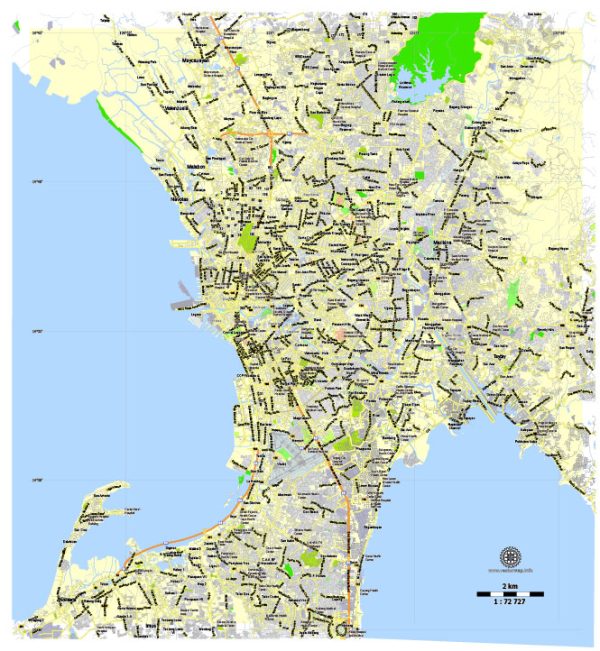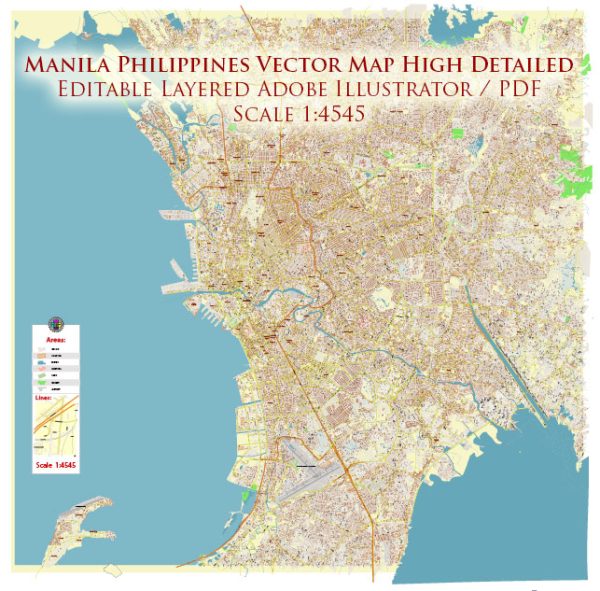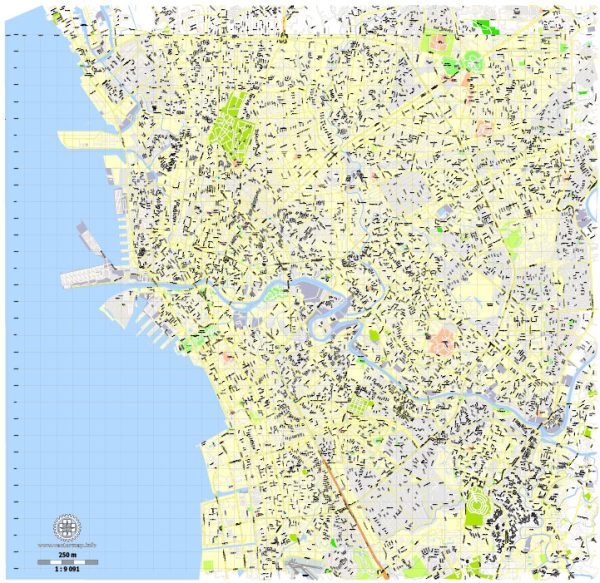Manila, the capital city of the Philippines, is rich in history and culture, with a blend of Spanish, American, and Asian influences. There are numerous historic places, buildings, streets, and squares that reflect the city’s diverse past.
Vectormap.Net provide you with the most accurate and up-to-date vector maps in Adobe Illustrator, PDF and other formats, designed for editing and printing. Please read the vector map descriptions carefully.
Here’s a detailed description of some of them:
- Intramuros:
- Description: Intramuros, meaning “within the walls” in Spanish, is the historic walled area of Manila. It was the center of political, religious, and military power during the Spanish colonial period. The area is surrounded by massive stone walls and contains well-preserved colonial architecture, including Fort Santiago, Manila Cathedral, and San Agustin Church.
- Fort Santiago: This citadel served as a defense fortress during the Spanish era and later as a prison during World War II. It now houses a museum showcasing the country’s history.
- San Agustin Church:
- Description: Located within Intramuros, San Agustin Church is the oldest stone church in the Philippines. Built in 1607, it features Baroque architecture and has been recognized as a UNESCO World Heritage Site. The church also houses a museum displaying religious artifacts and colonial-era items.
- Manila Cathedral:
- Description: Also situated in Intramuros, the Manila Cathedral is one of the country’s oldest churches. Originally built in 1581, it has undergone several renovations and is known for its impressive architecture, including stained glass windows and intricate carvings.
- Rizal Park (Luneta Park):
- Description: This historical urban park is dedicated to the country’s national hero, Jose Rizal. It features a monument commemorating Rizal’s execution and a kilometer-long promenade along Manila Bay. The park has gardens, fountains, and statues, making it a popular spot for locals and tourists alike.
- Malacañang Palace:
- Description: The official residence and workplace of the President of the Philippines, Malacañang Palace has a rich history dating back to Spanish colonial times. The palace complex includes the main Palace, Kalayaan Hall, and the Bahay Pangarap (House of Dreams).
- Bonifacio High Street:
- Description: Located in the Bonifacio Global City (BGC), this modern commercial district contrasts with the historical sites. It’s a bustling area with high-end shops, restaurants, and entertainment options. The design of the street and buildings is influenced by Western urban planning.
- Ayala Museum:
- Description: Situated in Makati, the Ayala Museum showcases Filipino culture and history through art exhibitions, artifacts, and interactive displays. It provides insights into the pre-colonial, colonial, and contemporary periods of Philippine history.
- Escolta Street:
- Description: Once known as the “Queen of Streets,” Escolta was Manila’s primary commercial district during the American colonial period. Although not as bustling as it once was, it still retains some historic buildings and serves as a reminder of the city’s past.
- Manila Chinatown (Binondo):
- Description: Established in 1594, Binondo is the oldest Chinatown in the world. It’s a vibrant district known for its authentic Chinese restaurants, shops, and temples, including the Minor Basilica of San Lorenzo Ruiz, also known as Binondo Church.
These historic places, buildings, streets, and squares collectively tell the story of Manila’s evolution from a Spanish colonial outpost to a modern metropolis, preserving a rich tapestry of culture and heritage.




 Author: Kirill Shrayber, Ph.D.
Author: Kirill Shrayber, Ph.D.